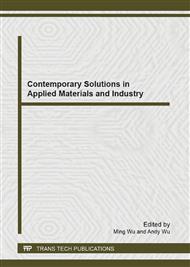p.70
p.75
p.81
p.86
p.94
p.100
p.105
p.109
p.113
Effects of Fly Ash on Heavy Metal Uptake of Rice Growing on Multi-Metal Contaminated Acidic Soil
Abstract:
The effects of fly ash on heavy metal uptake by rice and Cd, Pb, Cu and Zn availibility in contaminated acidic soil were investigated in this study. The fly ash was added at 0, 20 and 40 g·kg-1 dry weight soil, respectively. The results indicated that the addition of 20 g·kg-1 fly ash significantly improved dry weights of leaves, stems and roots of rice. While at the rate of 40 g·kg-1 fly ash, the dry weithts of leaves and stems of rice decreased. It was also showed that the application of fly ash substantially increased soil pH values from 4.0 to 5.1 and 6.4, and the higher increment was improved by the higher dosage. Further more, the addition of fly ash substantially decreased the avalibility of heavy metals, and the higher amendment dosage resulted in the lower NH4NO3 extractable heavy metal concentrations. These results demonstrated that the application of fly ash at 20 g·kg-1 might be an effective strategy to decrease rice metal uptake and remediate heavy metal contaminated acidic soil.
Info:
Periodical:
Pages:
94-99
Citation:
Online since:
April 2013
Authors:
Keywords:
Price:
Сopyright:
© 2013 Trans Tech Publications Ltd. All Rights Reserved
Share:
Citation:


